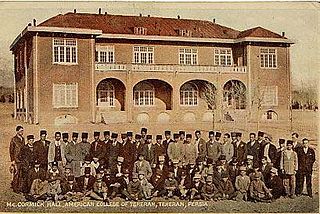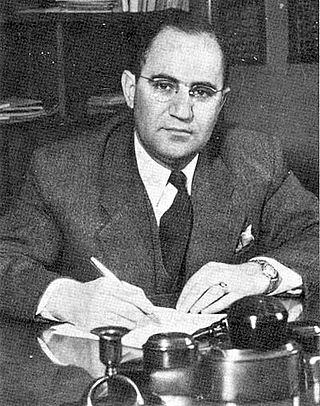
The University of Tehran is the oldest and most prominent Iranian university located in Tehran, Iran. Based on its historical, socio-cultural, and political pedigree, as well as its research and teaching profile, UT has been nicknamed "The Mother University [of Iran]". In international rankings, UT has been ranked as one of the best universities in the Middle East and is among the top universities of the world. It is also the premier knowledge producing institute among all OIC countries. Tehran University of Medical Sciences is in the 7th ranking of the Islamic World University Ranking in 2021. The university offers more than 111 bachelor's degree programs, 177 master's degree programs, and 156 PhD. programs. Many of the departments were absorbed into the University of Tehran from the Dar al-Funun established in 1851 and the Tehran School of Political Sciences established in 1899.

Andrew Michael Spence is a Canadian-American economist and Nobel laureate.

The Hoover Institution is an American public policy think tank and research institution that promotes personal and economic liberty, free enterprise, and limited government. While the institution is formally a unit of Stanford University, it maintains an independent board of overseers and relies on its own income and donations. Fellowship appointments do not require the approval of Stanford tenure committees. It is widely described as a conservative institution, although its directors have contested its partisanship.

The Golestan Palace, also transliterated as the Gulistan Palace and sometimes translated as the Rose Garden Palace from Persian language, was built in the 16th century, renovated in the 18th century and finally rebuilt in 1865. It is the former official royal Qajar complex in Tehran.

Lieutenant General Nasser Moghaddam served as the fourth and final chief of SAVAK from 6 June 1978 to 12 February 1979. He assumed the position after the arrest of General Nematollah Nassiri in 1978, following an order issued by the Shah. Moghaddam, along with Nassri and Nassiri's predecessor, Hassan Pakravan, was found guilty of corruption and subsequently sentenced to death on 11 March 1979, in accordance with the order of Ayatollah Khomeini.

Iran has a large network of private, public, and state affiliated universities offering degrees in higher education. State-run universities of Iran are under the direct supervision of Iran's Ministry of Science, Research and Technology and Ministry of Health and Medical Education. According to article 3 of the Constitution of the Islamic Republic of Iran, Iran guarantees "free education and physical training for everyone at all levels, and the facilitation and expansion of higher education." ...

Farhang Mehr was an Iranian-born American Zoroastrian scholar and politician.

The National Library and Archives of Iran (NLAI) or National Library of the Islamic Republic of Iran is located in Tehran, Iran, with twelve branches across the country. The NLAI is an educational, research, scientific, and service institute authorized by the Islamic Consultative Assembly. Its president is appointed by the President of Iran. The NLAI is the largest library in the Middle East and includes more than fifteen-million items in its collections.

Sidney David Drell was an American theoretical physicist and arms control expert.

Hosein Alā was an Iranian politician who served as Prime Minister in 1951 and from 1955 to 1957.

Farah Pahlavi is the widow of the last Shah of Iran, Mohammad Reza Pahlavi, and was successively Queen and Empress (Shahbanu) of Iran from 1959 to 1979. She was born into a prosperous family whose fortunes were diminished after her father's early death. While studying architecture in Paris, she was introduced to the Shah at the Iranian embassy, and they were married in December 1959. The Shah's first two marriages had not produced a son—necessary for royal succession—resulting in great rejoicing at the birth of Crown Prince Reza in October of the following year. Diba was then free to pursue interests other than domestic duties, though she was not allowed a political role. She worked for many charities, and founded Iran's first American-style university, enabling more women to become students in the country. She also facilitated the buying-back of Iranian antiquities from museums abroad.

Gholam Reza Pahlavi was an Iranian prince and a member of the Pahlavi dynasty, as the son of Reza Shah and half-brother of Mohammad Reza Pahlavi, the last Shah of Iran.
Middle Eastern Americans are Americans of Middle Eastern background. This includes people whose background is from the various Middle Eastern and West Asian ethnic groups, such as the Kurds and Assyrians, as well as immigrants from modern-day countries of the Arab world, Iran, Israel, Turkey, and sometimes Armenia.

Pratt Institute School of Information, previously School of Information and Library Science (SILS), administers the oldest Library and Information Science program in North America. It was created in Brooklyn, New York City, in 1890 shortly after Melvil Dewey created such a program at Columbia University in 1887. Pratt School of Information is one of the six schools of Pratt Institute. Based in Manhattan, the school administers a master of information and library science degree program that has been accredited by the American Library Association since the 1924/1925 academic year.

Nasrollah Moghtader Mojdehi was an influential Iranian academician, professor of internal medicine, and public servant, having served as a Senator in the pre-revolutionary Iranian Senate, and Minister of Health in the Amouzegar Cabinet and for a short period in the Sharif-Emami Cabinet.

Academic relations between Iran and the United States are a branch of cultural relations between the two countries that became widespread, especially during the Pahlavi dynasty era.

Jahanshah Saleh (1905–1995) was an Iranian physician and politician. He served as health minister and education minister in the 1950s and 1960s. He was the obstetrician of Queen Farah Diba, spouse of Shah Mohammad Reza Pahlavi.


















